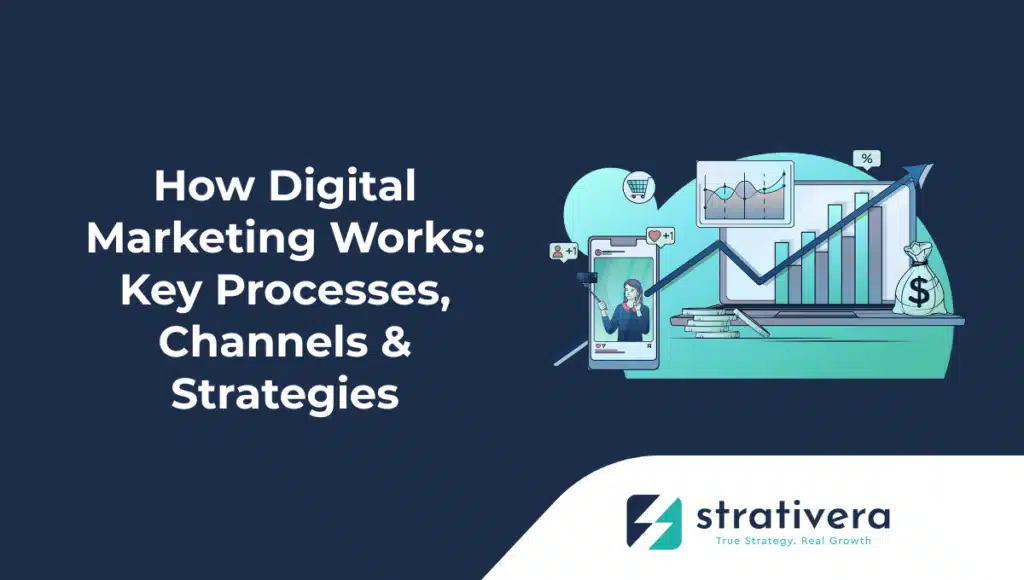Table of Contents
Digital marketing marks a huge shift in how businesses connect with customers today. It works by building strategies across online channels—like search engines, social media, email, and paid ads—to reach people where they already hang out online.
This approach lets companies send messages tailored for different moments in a customer’s buying journey.
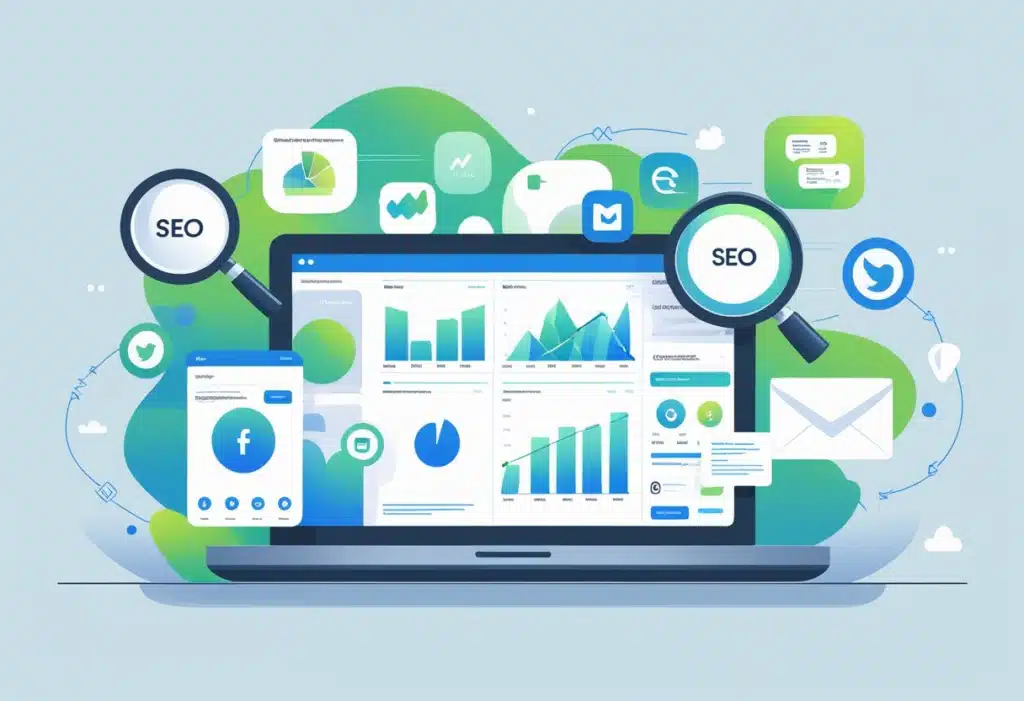
Digital marketing has come a long way from basic banner ads. Now, systems track user behavior, tweak campaigns on the fly, and show clear results.
Unlike old-school marketing, online campaigns give you analytics that reveal exactly how customers interact and what nudges them to buy.
Understanding how all these channels work together really matters if you want to stay competitive. Whether it’s SEO driving organic traffic or social media campaigns building brand awareness, each piece helps guide people from first discovery to final purchase.
Core Principles of Digital Marketing
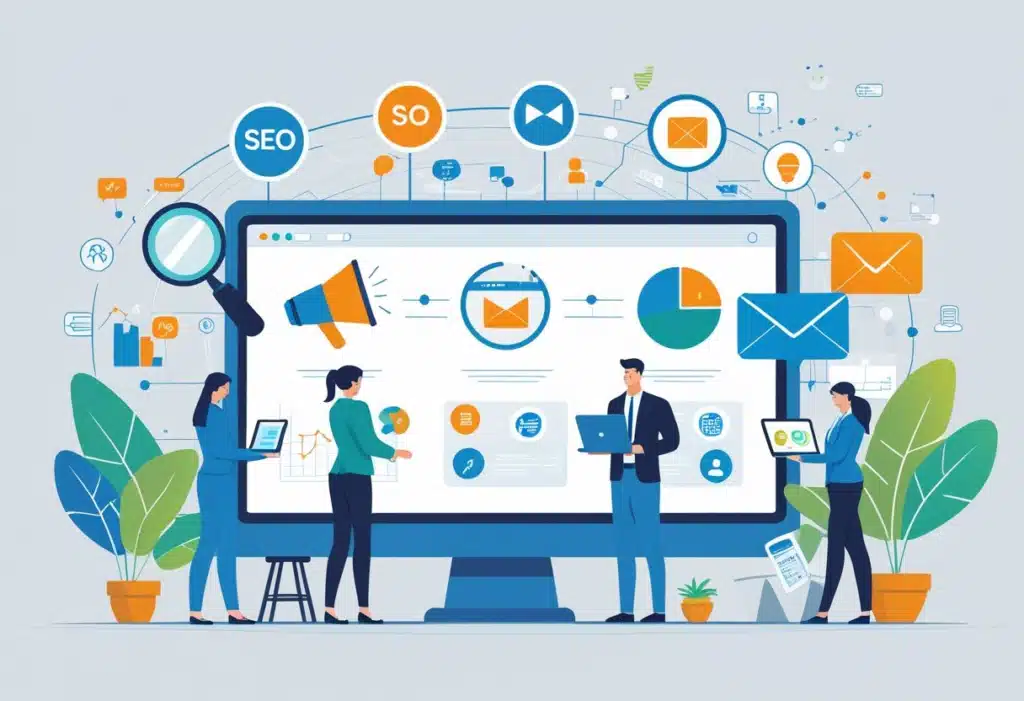
Great digital marketing boils down to three things: knowing your customers inside out, making decisions from real data, and understanding each step of the buying process.
Understanding Target Audience
Pinpointing and analyzing your audience is the backbone of any good digital campaign. Companies dig up demographic data, behavioral patterns, and psychographics to build detailed customer profiles.
Primary audience research methods include:
- Surveys and questionnaires
- Website analytics review
- Social media insights analysis
- Customer interviews and focus groups
When marketers really get what customers need or struggle with, they can personalize messages that actually resonate. That’s where the magic happens.
Things like location, age, income, and lifestyle shape how people interact with digital content. With advanced targeting, marketers can reach just the right groups, sometimes with almost eerie precision.
When content speaks directly to someone’s interests or problems, engagement jumps. Brands that show they “get it” usually see better conversion rates and stronger loyalty. Makes sense, right?
Data-Driven Decision Making
Analytics give digital marketers the numbers they need to steer campaigns. Tracking key performance indicators helps teams figure out what’s working and what needs tweaking.
Essential digital marketing KPIs include:
| Metric Type | Key Indicators |
|---|---|
| Traffic | Sessions, page views, bounce rate |
| Engagement | Click-through rate, time on site, social shares |
| Conversion | Conversion rate, cost per acquisition, return on ad spend |
With real-time data, marketers can quickly adjust campaigns or budgets. If something flops, they don’t have to wait weeks to fix it.
A/B testing is a staple—teams try out different headlines, images, or buttons to see what actually gets clicks. Sometimes the results are surprising.
Data privacy laws mean companies need to be upfront about how they collect and use data. It’s a balancing act between personalization and respecting privacy, and honestly, it’s not always easy to get right.
Customer Journey Mapping
Customer journey mapping lays out every interaction between a prospect and a brand. This big-picture view helps marketers spot ways to improve the experience and clear out roadblocks.
Typical customer journey stages:
- Awareness – Initial problem recognition
- Consideration – Solution research and comparison
- Decision – Purchase evaluation and selection
- Retention – Post-purchase experience and loyalty
Every stage calls for its own type of content. Awareness means education, while decision time is all about comparisons and proof.
People bounce between email, social, search, and websites on their way to a purchase. Marketers have to keep messaging consistent but also adapt to each platform’s quirks.
Mapping the journey highlights where customers drop off. Maybe checkout feels clunky, product info is lacking, or the mobile site just isn’t up to snuff.
How Digital Marketing Works in Practice
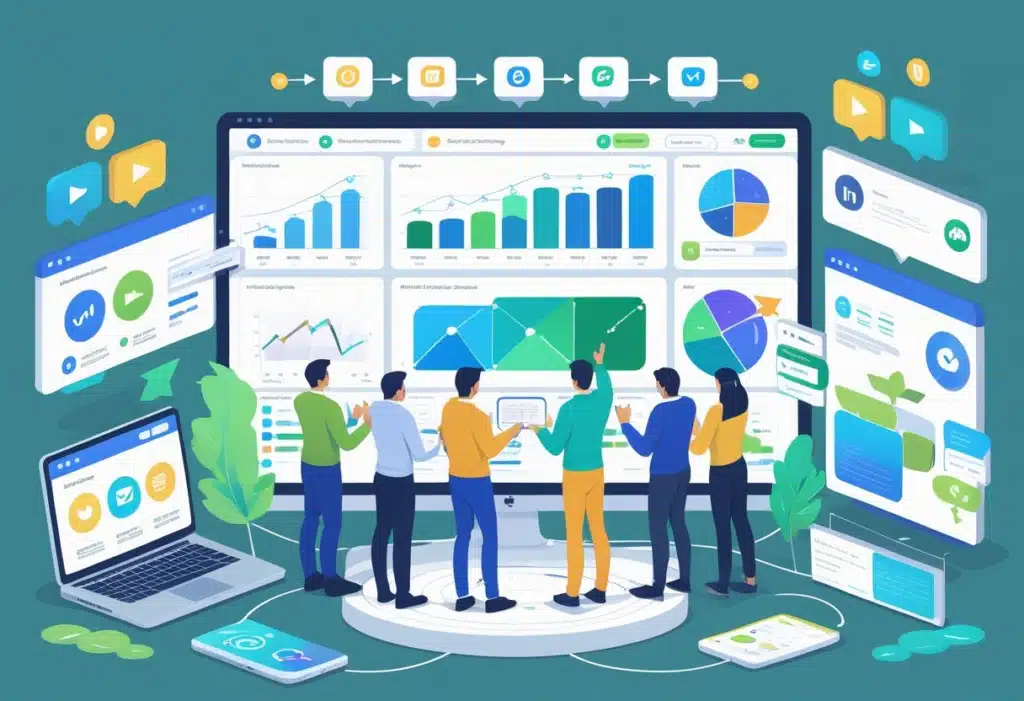
To succeed, digital marketing teams run coordinated campaigns across channels, target the right people, and constantly fine-tune to boost conversions and improve results.
Integrated Omnichannel Approach
A solid digital marketing strategy ties together every customer touchpoint for a seamless experience. That means the message stays consistent whether someone finds you on Google, Facebook, or in their inbox.
It starts by mapping the customer journey. Marketers look for where people discover the brand, do their research, and finally buy. Each spot along the way gets content designed to nudge them closer to a sale.
Channel Integration Example:
- Awareness Stage: SEO blog posts and social media content
- Consideration Stage: Email nurture sequences and retargeting ads
- Decision Stage: Landing pages and promotional offers
Cross-channel tracking shows which sources drive the most engagement and sales. That info helps marketers decide where to put their money and effort.
When branding and messaging line up across all channels, customers start to trust and remember you. Seeing the same value prop everywhere? That sticks.
Audience Targeting and Segmentation
Modern digital marketing lives and dies by precise audience segmentation. Marketers split their audience into groups based on things like demographics, behavior, and purchase history.
Behavioral segmentation often works best for boosting conversions. It sorts users by actions—like site visits, email opens, downloads, or past purchases.
Common Segmentation Criteria:
- Purchase frequency and value
- Website engagement metrics
- Geographic location
- Device preferences
- Traffic source origin
Each group gets content or offers tailored just for them. High-value customers might get premium recommendations, while newcomers could see welcome discounts or helpful guides.
Some platforms even let marketers adjust segments in real time. If a segment starts tuning out, teams can quickly change up the targeting or creative.
Dynamic segmentation means user profiles update automatically. When someone’s behavior shifts, they move to a new segment without anyone lifting a finger.
Conversion Rate Optimization
CRO is all about getting more visitors to take action. Marketers test and improve website elements that sway decisions.
A/B testing sits at the heart of CRO. Teams try out different headlines, button colors, form layouts, and page designs to see what works best.
Key CRO Metrics to Track:
- Conversion rate by traffic source
- Bounce rate on landing pages
- Time on page for key content
- Form completion rates
- Cart abandonment rates
Speed matters—a lot. Pages that load in under three seconds usually convert way better than slow ones.
Improving user experience makes it easier for people to convert. Simple forms, clear value props, and obvious call-to-action buttons help guide visitors where you want them to go.
Heat mapping tools show where users click and linger. This info points out where people drop off, so teams know what to fix.
Even small improvements across pages and campaigns add up. Over time, those little wins can mean big revenue growth.
Search Engine Marketing and SEO
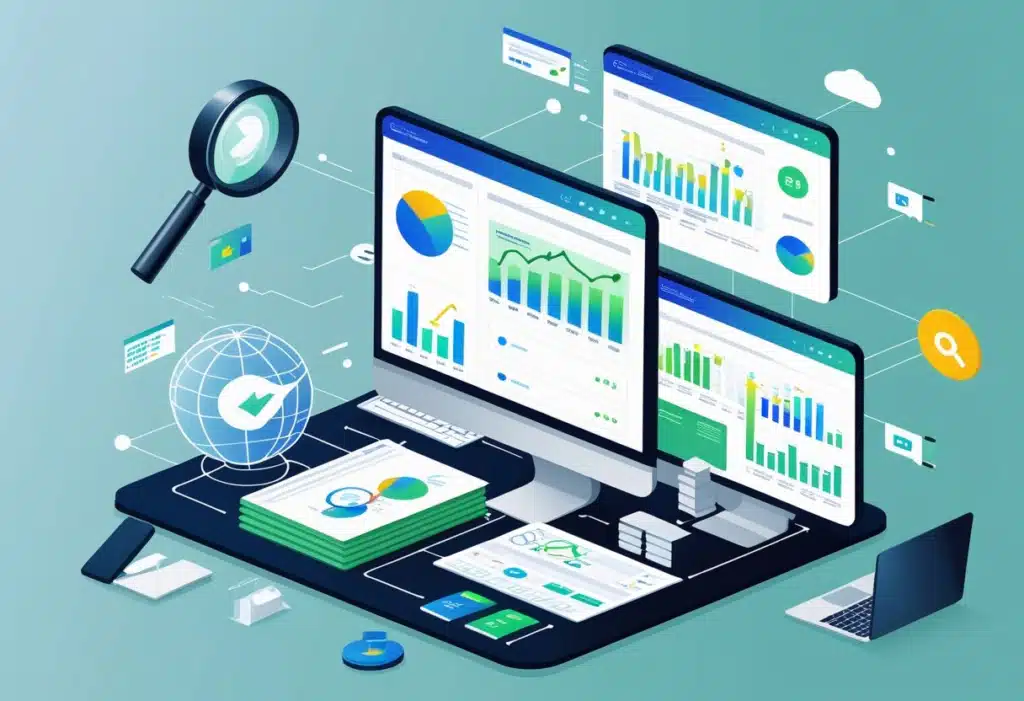
Search engines bring in most website traffic, both through organic listings and paid ads. SEO boosts visibility in unpaid results, while search engine marketing combines organic and paid tactics.
Search Engine Optimization Fundamentals
SEO comes down to three main steps: crawling, indexing, and ranking. Search engines send out bots to find web pages, analyze them, and store them in massive databases.
Crawling happens when these bots follow links to discover new content. Clear site structures and XML sitemaps help them find their way.
After crawling, indexing kicks in. Search engines store the info and decide which pages should show up for different search queries.
Ranking decides where your pages land on search results. Search engines look at relevance, quality, and user experience to set the order.
Keyword research is the heartbeat of SEO. Businesses find out what their audience searches for and create content that matches their intent.
SEO lets smaller sites compete with giants by building trust through top rankings. Organic traffic can keep growing without pouring money into ads forever.
On-Page and Off-Page SEO
On-page SEO means optimizing individual web pages for better search visibility. Here are the essentials:
- Title tags under 60 characters with target keywords
- Meta descriptions that boost click-throughs
- Header tags (H1, H2, H3) for structure
- Internal links between related pages
- Image alt text for accessibility and SEO
Quality content matters most. Pages need to answer user questions and include keywords naturally—no keyword stuffing, please.
Off-page SEO builds authority through outside signals. Backlinks from trusted sites count as votes of confidence and can lift your rankings.
Effective link building strategies include:
- Creating shareable, high-quality content
- Guest posting on industry websites
- Building relationships with relevant publishers
- Earning brand mentions and citations
Social media and influencer outreach help spread your content further. The more people see and share your stuff, the better your odds of picking up natural backlinks.
Search Engine Marketing Strategies
Search engine marketing covers both organic SEO and paid ads to boost search visibility. SEM gives brands coverage across search engine results pages.
Google Ads stands out as the main paid search platform. Advertisers bid on keywords and pay when someone clicks the ad. Quality Score shapes ad position and costs.
Quality Score depends on:
- How relevant your ad is to the search
- Landing page experience
- Expected click-through rate
- Account history
Paid search brings instant visibility and lets you target by demographics, location, and device. You can get pretty granular with your audience selection.
Integration strategies blend SEO and paid ads for better results. Some businesses test keywords with paid ads before committing to long-term SEO.
Keyword data from paid campaigns helps shape organic content. Companies often advertise for tough keywords while building organic rankings for easier ones.
Content Marketing and Content Types
Content marketing drives digital success by creating and sharing valuable materials that attract and engage your audience. Businesses use everything from written guides to videos and podcasts to build authority and generate leads.
Content Creation Essentials
Content creation sits at the heart of digital marketing. Brands need a strategy that matches what their audience wants and fits their goals.
The process kicks off with audience research and keyword analysis. Companies look for topics their market cares about. This research shapes content planning and helps with visibility.
Content planning relies on a few basics:
- Editorial calendars for steady publishing
- Content pillars that tie back to business goals
- Distribution across different channels
- Metrics to track performance
Different content types let brands reach people with different preferences. Some folks love visuals, others want to read.
Content creators juggle quality and quantity. Sticking to brand guidelines and having efficient workflows helps keep things consistent.
Blog Posts and Guides
Blog posts still work well for most businesses. Over half of content marketers say blog posts perform best compared to other formats.
Written content does a lot in digital marketing. Blog posts help with SEO by targeting keywords and updating your site with fresh info. They also show expertise and give customers real solutions.
Great blog content usually includes:
- How-to guides for specific problems
- Industry insights to show expertise
- Product comparisons for buyers on the fence
- Case studies that show actual results
Long-form guides dive deep into complex topics. These tend to bring in more backlinks and shares. They help position a brand as an authority.
Businesses should optimize blog posts for search engines, but also keep them readable. That balance brings in organic traffic and keeps readers engaged.
Infographics, Videos, and Podcasts
Visual and audio formats reach people who learn or consume content differently. Infographics break down complex info with simple graphics and minimal text. They grab attention fast.
Video marketing pulls audiences in with stories and visuals. YouTube, for example, offers huge reach for brands making good videos. Tutorials, product demos, and behind-the-scenes clips all work well.
Popular video formats:
- Tutorials that teach skills
- Product demos showing features
- YouTube Shorts for quick hits
- Webinars for deeper dives
Podcasts bring audio content to people on the move. Podcasts can show off expertise and authenticity—great for listeners during a commute or workout.
These formats need different resources than written content. Still, they often get more engagement and can be reused across channels. One video might become a blog post, a set of social clips, and even a podcast episode.
Ebooks offer in-depth resources and often help with lead generation through gated content.
Social Media Marketing and Platforms
Brands use organic social strategies to build real connections with audiences, while paid ads boost reach on platforms like Facebook, Instagram, and TikTok. Working with influencers and affiliates helps brands tap into trusted voices and pay based on performance.
Organic Social Media Strategies
Social media marketing means creating and sharing content to connect with your audience and grow brand recognition. Companies build content calendars with images, videos, stories, and interactive posts for each platform.
Platform-Specific Approaches:
| Platform | Best Content Types | Key Features |
|---|---|---|
| Visual posts, Stories, Reels | Hashtags, shopping tags | |
| Professional articles, industry updates | B2B networking, thought leadership | |
| TikTok | Short-form videos, trends | Algorithm-driven discovery |
| Community posts, events, groups | Detailed audience targeting |
Brands track likes, comments, shares, and reach to see what works. Most platforms offer analytics to help you understand your audience and tweak your timing.
Community management means replying to comments, messages, and mentions to build relationships. Brands use social listening tools to keep tabs on brand mentions and industry chatter across platforms.
Social Media Advertising
Social media ads use paid promotions to reach people outside your organic followers. Platforms give you targeting options for age, location, interests, behaviors, and custom audiences.
Common Ad Formats:
- Sponsored posts show up in users’ feeds
- Video ads grab attention with motion and sound
- Carousel ads let you feature multiple products
- Story ads give a full-screen experience
Companies pick campaign goals like awareness, traffic, leads, or conversions. Each goal changes where your ad shows, how you bid, and what you measure.
Retargeting campaigns go after users who’ve already visited your site or engaged with your content. These ads usually convert better since the audience already knows the brand.
Budgets differ by platform and audience size. Most companies start small, test, and then scale up what works across channels.
Influencer and Affiliate Marketing
Influencer marketing links brands with creators who already have an audience. Companies look for influencers whose followers match their target market and vibe with their brand.
Influencer Categories:
- Micro-influencers (1K-100K followers) bring high engagement
- Macro-influencers (100K-1M followers) offer broader reach
- Celebrity influencers (1M+ followers) give max visibility
Affiliate marketing rewards partners for sales made through special links or codes. Many social campaigns include affiliate pieces where influencers earn commission on purchases.
Brands use affiliate networks or direct deals to manage these relationships. Pinterest and Instagram make it easier for affiliates to tag products right in their posts.
Performance tracking covers clicks, conversions, and return on ad spend. Lots of brands mix influencer content with paid ads to reach beyond the influencer’s usual audience.
Paid Advertising Channels
Paid advertising lets brands buy visibility across digital platforms. The big two: search-based ads for users actively looking, and visual ads that grab attention through placement.
Pay-Per-Click Advertising Basics
Pay-per-click ads run on a simple idea—advertisers only pay when someone clicks. It’s a cost-effective way to get clear results.
PPC platforms like Google Ads and Microsoft Advertising show ads above organic results. Advertisers bid on keywords tied to their products or services.
Bidding determines ad placement. Higher bids and better ad quality score mean better visibility for your keywords.
Budget control is a big plus for PPC. Brands set daily limits and tweak bids based on click-through and conversion rates.
PPC gets brands instant visibility for high-intent searches. People looking for solutions are more likely to convert than those just browsing.
Some industries, like legal and finance, see higher costs per click because of stiff competition.
Display and Native Advertising
Display ads use banners on websites, apps, and social platforms. These focus on brand awareness, not always on immediate sales.
Native ads blend in with the content around them, like sponsored articles or recommended posts. This helps avoid ad blindness and keeps users engaged.
Targeting for both formats covers demographics, interests, behavior, and retargeting. Advertisers can zero in on pretty specific groups.
Google Display Network, for example, puts ads on millions of sites. That reach is great for building recognition.
Creative formats range from basic banners to interactive media. Video and animated graphics usually get more engagement than static images.
Native ads often get higher click-through rates because they match the platform’s style. Users interact more when ads don’t interrupt their experience.
Both channels work well for retargeting—showing ads to users who already visited your website or engaged with your stuff.
Email and Mobile Marketing
Email marketing sends targeted messages to people who’ve opted in. Mobile marketing makes sure those campaigns look good and work well for folks checking emails on phones or tablets.
Email Marketing Techniques
Modern email marketing leans on strategic segmentation and personalization, not just blasting out messages to everyone. Advanced segmentation tools let businesses group audiences by demographics, behaviors, purchase history, and engagement levels.
Automated workflows send emails triggered by specific user actions. Welcome series greet new subscribers, and abandoned cart sequences try to win back lost sales.
Re-engagement campaigns reach out to inactive subscribers. That’s usually worth the effort, though results vary.
AI-powered personalization builds dynamic content that shifts with individual preferences. Product recommendations update based on browsing history.
Send times adjust for when each recipient usually opens their emails. It’s a small tweak, but it matters.
A/B testing looks at subject lines, content, and calls-to-action. Small test groups get different versions before the winner goes out to everyone.
List hygiene keeps deliverability high by scrubbing inactive subscribers and invalid addresses. Double opt-in helps make sure new subscribers are actually interested.
Newsletters and Email Campaigns
Newsletters deliver consistent value—think educational content, industry updates, or company news. They help build brand authority and keep regular contact outside of pure promotions.
Content mix means balancing educational articles, product spotlights, and exclusive offers. The 80/20 rule suggests 80% valuable stuff and 20% promos.
Email frequency depends on your industry and what your audience likes. Weekly newsletters suit most businesses, while daily emails fit news orgs or ecommerce.
Design elements matter more than you’d think. Responsive templates should display right on any device.
Clear headlines, scannable text, and big call-to-action buttons all help boost engagement.
Performance metrics show how campaigns are doing:
| Metric | Good Rate | Excellent Rate |
|---|---|---|
| Open Rate | 15-25% | 25%+ |
| Click Rate | 2-5% | 5%+ |
| Unsubscribe Rate | <0.5% | <0.2% |
Deliverability factors include sender reputation, authentication protocols, and avoiding spammy words in subject lines or content. There’s a bit of an art to it.
Mobile Marketing Strategies
Mobile email marketing means optimizing campaigns for smartphones and tablets—where most people actually read their messages. Mobile devices now account for about 60% of email opens.
Responsive design tweaks email layouts for any screen size. Single-column templates work better than multi-column ones on phones.
Subject line optimization keeps the good stuff within the first 30 characters. Mobile screens cut off longer text, so that’s all most people see.
Preheader text gives a little more preview. It’s easy to forget, but it helps.
Touch-friendly elements mean big buttons and enough space between links. A minimum button size of 44×44 pixels makes tapping easier.
Loading speed can make or break mobile engagement. Compressed images and simple HTML help emails load faster, especially on spotty cellular networks.
SMS integration works alongside email campaigns for time-sensitive alerts and reminders. Text messages get opened more, but you’ve got character limits and per-message costs to think about.
Analytics, ROI, and Future Trends
Modern digital marketing success really comes down to accurate measurement, automation, and smart personalization. Analytics changes marketing ROI by offering data-driven insights that help tweak campaigns and even predict what’s next.
Measuring and Optimizing ROI
Marketers use analytics platforms to track ROI across different channels. Google Analytics gives detailed data on user behavior, conversion paths, and campaign performance.
To measure ROI well, you need clear attribution models. First-click, last-click, and multi-touch attribution show which touchpoints actually drive conversions.
Key performance indicators include:
- Customer acquisition cost (CAC)
- Customer lifetime value (CLV)
- Return on advertising spend (ROAS)
- Conversion rate by channel
Digital marketing ROI analytics in 2024 puts a spotlight on predictive modeling and real-time optimization. Advanced analytics tools sift through huge amounts of data to spot patterns and help with budget decisions.
Marketers pull in data from social media, email tools, and CRM systems. This gives them a full picture of customer interactions and how campaigns perform.
Digital Marketing Automation
Marketing automation platforms handle repetitive tasks and help campaigns run smoother. Tools like HubSpot automate emails, lead scoring, and customer segmentation.
Automated workflows fire off specific actions based on what users do. If someone downloads content, the system sends follow-up emails and updates lead scores on its own.
Key automation features include:
- Email drip campaigns
- Lead nurturing sequences
- Social media scheduling
- Personalized content delivery
Automation cuts down on manual work and keeps communication steady with prospects. Marketers get to focus on strategy while systems handle busywork.
Advanced automation uses behavioral triggers and dynamic content. The system changes messaging automatically based on what users like or buy.
AI, Machine Learning, and Personalization
AI is shaking up digital marketing ROI analytics with machine learning algorithms that predict customer behavior and tweak campaigns in real time.
Machine learning chews through big datasets to find customer segments and predict buying patterns. These insights make advertising more targeted and personalize content suggestions.
AI in marketing includes:
- Predictive customer scoring
- Dynamic pricing optimization
- Chatbot interactions
- Content personalization
Personalization engines dig into user data to deliver custom experiences everywhere. Websites show relevant products, emails get tailored recommendations, and ads target specific interests.
Marketing analytics strategies use AI for automated bidding, audience targeting, and creative tweaks. Machine learning keeps improving campaigns by analyzing data in real time.
Advanced personalization looks at browsing history, demographics, and buying behavior. Systems build customer profiles to guide every marketing interaction.
FAQs – How Digital Marketing Works
Digital marketing takes strategic planning, picking the right platforms, and tracking performance. Knowing the strategies, benefits, and learning paths helps businesses and individuals figure out the digital world—though it’s always changing.
What are the key steps involved in implementing digital marketing for a business?
Businesses start digital marketing by setting clear goals and identifying their target audience. This foundation shapes every other marketing move.
The next step is picking the right digital channels based on where the audience hangs out online.
Companies usually go for social media, search engines, email, and websites to reach people where it counts.
After that, it’s all about creating content and building campaigns. Businesses make sure content fits customer needs and keeps the brand message steady.
Performance tracking and tweaking finishes out the process. Companies watch website traffic, conversion rates, and engagement to keep making things better.
Can you explain the different types of digital marketing strategies?
Social media marketing targets users on platforms like Facebook, Instagram, TikTok, and LinkedIn. Over 308 million Americans use social networks monthly, so it’s a solid way to boost brand visibility.
Search engine optimization (SEO) is about getting your website to rank higher in organic search results. It taps into the 8.5 billion daily Google searches for free traffic.
Pay-per-click advertising charges you for every click on your digital ads. Google Ads is the biggest PPC platform, and paid ads show up above organic results.
Email marketing brings in an average of $32 for every dollar spent. Retail and ecommerce see even more—sometimes $45 per dollar.
Mobile marketing reaches over 310 million smartphone users in the U.S. Text messages get open rates as high as 98%—pretty wild.
Content marketing covers blogs, videos, and infographics to educate audiences. It builds authority without being pushy about selling.
How can digital marketing benefit an organization or individual?
Digital marketing lets brands keep in touch with audiences and show expertise. Companies answer common questions and share insights to build trust.
It’s usually more cost-effective than traditional marketing. Digital campaigns can run on any budget, from DIY efforts to hiring agencies.
Targeting gets super precise, reaching only the people you want by demographics, interests, or behaviors. That saves money and effort.
Real-time performance tracking means you can tweak campaigns on the fly. Marketers watch click-through rates, conversions, and engagement to keep improving.
Global reach is a big plus—small businesses can compete with the big guys online.
In what ways does digital marketing differ from traditional marketing?
Digital marketing gives immediate feedback with analytics and tracking. Traditional methods like print and radio barely offer any performance data.
Targeting in digital marketing can reach specific user segments. Traditional marketing just broadcasts to everyone and hopes for the best.
Digital marketing offers flexible budgets. Traditional media usually wants big upfront payments and fixed pricing.
Digital channels let brands and customers talk back and forth. Traditional marketing is usually a one-way street.
Speed is another difference. Digital campaigns can launch in hours or days, while traditional ads take weeks or months to get started.
Digital content sticks around and stays searchable. Traditional ads disappear once they’re done running
How can beginners effectively learn and apply digital marketing principles?
Beginners should check out free resources like Google’s Digital Marketing Courses and HubSpot Academy. No need to spend money just to get started.
Hands-on practice is the fastest way to learn. Running a blog, managing social media, or trying small ad campaigns all build real skills.
Following industry news and thought leaders keeps you up to date. Digital marketing changes fast, so you’ve got to keep learning.
It’s smart to focus on one area at first, like social media or email marketing. Otherwise, it gets overwhelming.
Networking helps too. Online groups and local meetups offer support and real-life advice.
Certifications from Google Ads or Facebook Blueprint add credibility. They help when you’re looking for jobs or clients.
What are some common examples of digital marketing in action?
E-commerce companies often run retargeting ads to bring back website visitors who didn’t buy anything. You’ll see these personalized ads popping up on different sites and social feeds—it’s almost uncanny.
Software companies like to publish helpful blog posts that show up near the top of search results. People looking for solutions stumble across these articles and sometimes end up becoming customers.
Restaurants get creative on social media, showing off menu items and limited-time deals. Those Instagram and Facebook posts spark conversations and, hopefully, get people in the door.
B2B brands tap into LinkedIn ads to reach decision-makers in their target industries. They usually aim those messages at specific job titles or company types, hoping to catch the right eyes.
Service providers send out automated email sequences to keep leads interested over time. These emails share useful info and help folks remember the brand exists.
Subscription services team up with influencers to get in front of new crowds. Content creators try out the products and share their experiences with their loyal followers, which can make all the difference.

